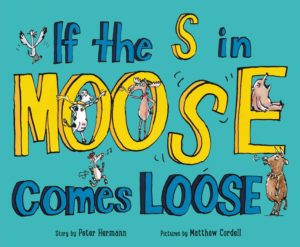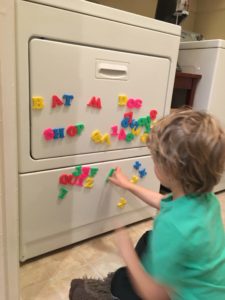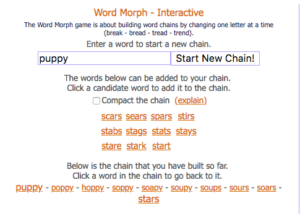 Why I Picked It Up: The credit for this one goes to my youngest child who was giggling while she pulled a handful of books off the shelf at our new library. Most of them went back on the shelf, but the clever, rhythmic title of this one caught my eye!
Why I Picked It Up: The credit for this one goes to my youngest child who was giggling while she pulled a handful of books off the shelf at our new library. Most of them went back on the shelf, but the clever, rhythmic title of this one caught my eye!
Why I Finished It: I honestly didn’t have time to look through it before we left the library, but after the smallest collapsed for her nap, the oldest and I sat down to read. I wasn’t exactly sure where the question in the title was going to take us, but my son got the hiccups from laughing so hard before we were done!”
“If the S in MOOSE comes loose, and the E breaks free…what’s left?” You’re left with MOO of course! The poor lonely cow, lost without her moose, decides she can just glue the two runaway letters back in place, but since she’s out of glue, she has to spell it. Her quest to beg, borrow, steal and trade the letters she needs is hilariously illustrated in a style that reminded me a bit of Quentin Blake and the Roald Dahl books.
My son already loves to play with words and letters (I wonder where he gets that from…) so he thoroughly enjoyed playing along with the author and trying to guess what would happen when the cow borrowed a certain letter from a word. This was certainly a winner for us!
Who I Would Give It To: I would read this aloud in PreK or early elementary as a fun way to practice phonemic awareness and spelling patterns.
Integration Ideas:
Spelling and Vocabulary
I loved how If the S in MOOSE Comes LOOSE turned the letters into independent objects that can be rearranged pretty easily to make new meaning. In an interview, the author views rhyming as “a playful way to organize the world” – I love that! My (just starting to read) son now asks at least once a day what would happen if this letter came loose from that word we were just using in our conversation. It definitely sparks even more conversation and gets him thinking about the sounds and how they go together to make words! Teacher win!

Students should definitely be allowed to play with their words! There is a lot of self-discovery that can happen as students arrange and rearrange the words, lots of opportunity for teachable moments and conversations as students come up with “words” that you may not find in a dictionary. They might find a new word, and as long as they are able to sound it out, it could be the basis for a whole new story (see below).
My first impulse was to use the magnetic letters that you put on the fridge, but I also found few technology tools to help keep workstations clear:
- http://www.bigbrownbear.co.uk/magneticletters/
- http://www.abcya.com/alphabet_number_magnets.htm
- http://www.readwritethink.org/classroom-resources/student-interactives/word-mover-b-30964.html (You could type your own set of magnets with just one letter on each)
Writing/Storytelling
Dr. Seuss’s hallmark is made-up words, and he frequently replaces the first letter of a word with a new letter to create some of his imaginative creatures (the wocket in my pocket comes to mind…). As a natural extension of playing with words, students can take their made-up words and develop meanings or a story for them.
 Though If the S in Moose Comes Loose isn’t exactly a word chain, it is based around a group of words where the letters have been interchanged to make new words. That made me think of word chains: transforming words from one to another by changing one letter at a time. For example, going from DOG to CAT or SEAL to BALL (seal, seat, beat, beam, team, meat, melt, belt, bell, ball). Students could generate word chains using this handy little tool: http://xworder.com/MorphBuild.aspx that lets them choose from a list of words that could possibly be created if one letter was changed. Then, they could see if they can write a story that ties everything together, with illustrations, of course!
Though If the S in Moose Comes Loose isn’t exactly a word chain, it is based around a group of words where the letters have been interchanged to make new words. That made me think of word chains: transforming words from one to another by changing one letter at a time. For example, going from DOG to CAT or SEAL to BALL (seal, seat, beat, beam, team, meat, melt, belt, bell, ball). Students could generate word chains using this handy little tool: http://xworder.com/MorphBuild.aspx that lets them choose from a list of words that could possibly be created if one letter was changed. Then, they could see if they can write a story that ties everything together, with illustrations, of course!
Making Connections
Peter Hermann has loved rhyming words ever since he recited “If the World Was Crazy” by Shel Silverstein in 4th grade (full text of that poem here). Older students could compare and contrast the two texts, If the S in Moose Comes Loose and “If the World Was Crazy”, especially noticing the similarities in tone and rhyme.
Here’s a video of the author explaining where he got the idea for If the S in Moose Comes Loose:
This video is of the author acting in his role as Charles Brooks, a publisher, on TV show Younger, reading his own book:
Tell us your favorite ways to teach word work!






Leave a Reply